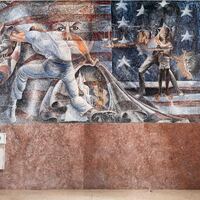Untitled mural by Edward Mills

Edward Mills’ mural details a nation in turmoil. It is a rich and complex composition. On the left side of the mural, the words “Injustice,” “Inequality,” and “Bigotry” are scrawled, with “Black Power” written just beneath. Faceless, white figures drag a Black woman who is holding a sign, while, above, a mass of Black people appear to be protesting. Dr. Martin Luther King, Jr. appears with his fist raised, overlapping with a policeman holding a nightstick and German Shepherd. In the middle of the mural, an unknown white man’s face looms large. In the foreground, a man either lifts or pulls down the American flag to reveal or conceal the ugly realities of racism, like the Ku Klux Klan. Chained Black people appear in the sole of the man’s shoe, one of whose hands is nailed to a crucifix. On the right side of the mural, a Black man extends his arm with a scale in his hand, and a Black boy holds a torch. Above them, the ghostly figures of John F. Kennedy and Robert F. Kennedy fade into the background. A small portrait of Stokely Carmichael/Kwame Ture breaks through the American flag.
Mills’ mural reflects the tumultuous and radical period of his youth. He attended Texas Southern University during the late 1960s and 1970s, during the height of the Civil Rights era and Black Power movement. Activists and radical figures were frequent visitors to campus, including Stokely Carmichael/Kwame Ture, who spoke at TSU in spring 1967. Shortly after, the so-called “TSU Riots” occurred when Houston Police responded to a student protest by firing thousands of rounds of ammunition into a student dormitory and arresting 500 students. These first hand encounters with oppression and resistance surely influenced Mills’ thinking and artwork. Multiple classmates of Mills describe him as a leader and talented artist. One classmate and artist, Barry Morris, calls Mills “the revolutionary.” One example of Mills’ revolutionary thought may be the depiction of slavery on the sole of the mural’s main figure’s shoe; perhaps the artist hints that slavery is the soul of the United States. Other classmates also say that Mills is color-blind, which may explain the muted palette of his masterful mural.
Learn more:
William North IV - SYMBOLS OF RESISTANCE IN A TEMPLE TO THE IMAGINATION: THE MURALS OF TEXAS SOUTHERN UNIVERSITY
This program is made possible in part by a grant from Humanities Texas, the state affiliate of the National Endowment for the Humanities.
